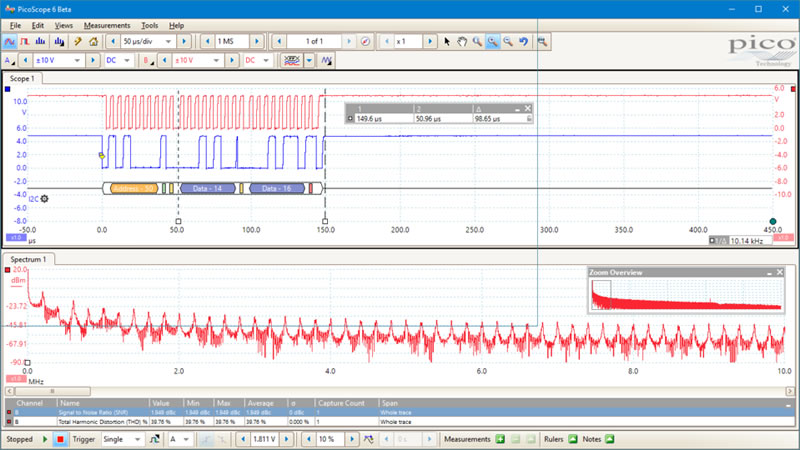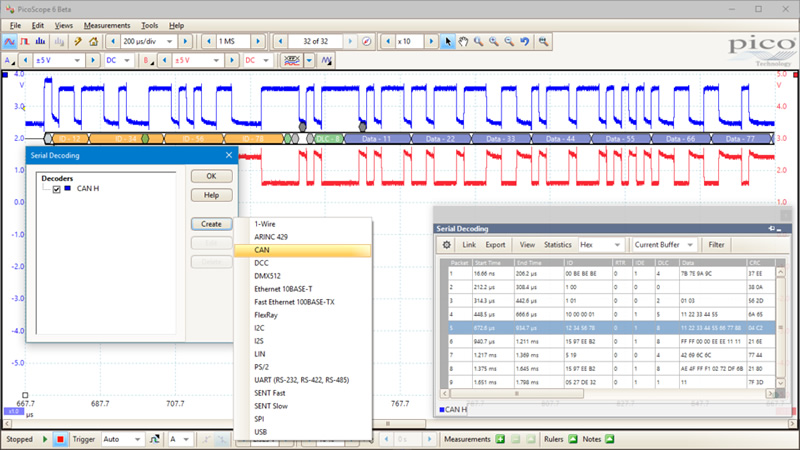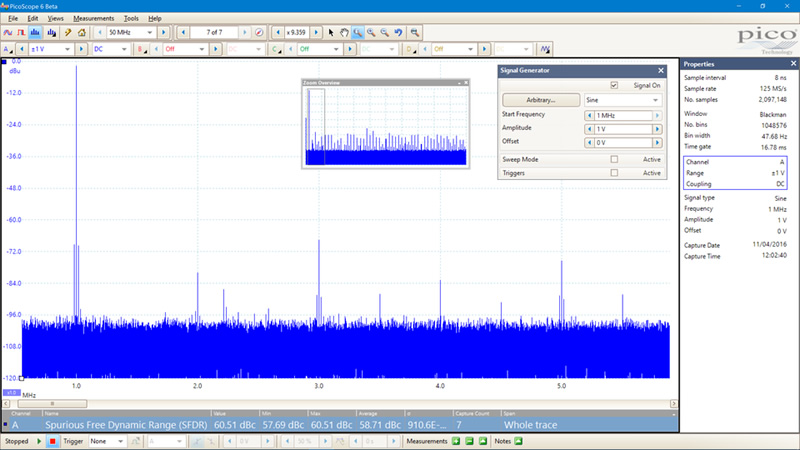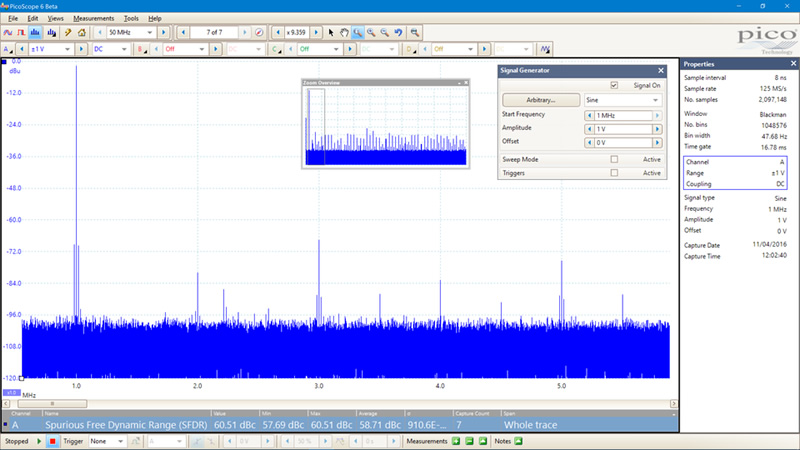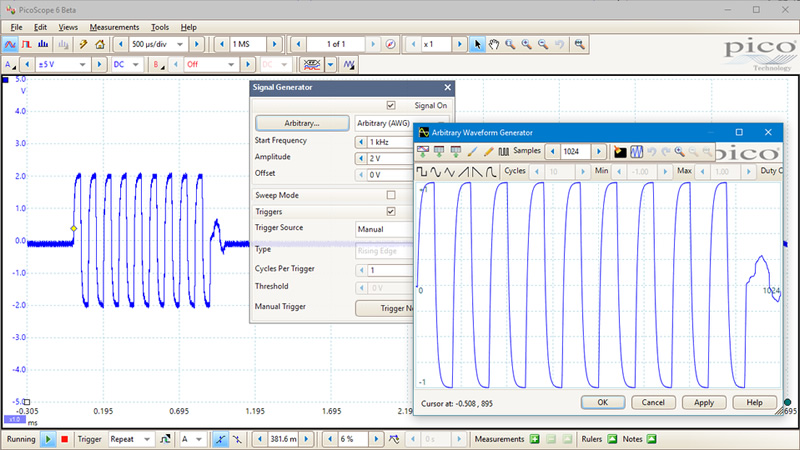Oscilloscopes
- |
- Automotive
- |
- Data Acquisition
- |
- Electrical
- |
- Environmental
- |
- Food Safety
- |
- Mechanical Measurement
- |
- Multimeters
- |
- Test & Measurement
- |
- Temperature Monitoring
- |
- Test Accessories
- |
- Thermometers
- |
- 2 channel, 4 channel and MSO models
- Up to 100 MHz bandwidth
- Decode 15 serial protocols as standard
- Windows, Linux and Mac software
- 6 instruments in one
- Ultra-compact design
- Up to 128 MS buffer memory
- USB connected and powered
(click tab)
- 2 Channels
- 2 Channels + MSO
- 4 Channels
|
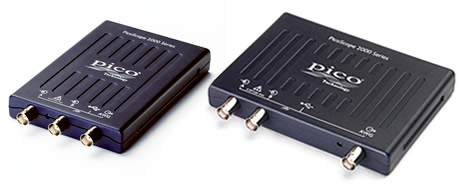
|
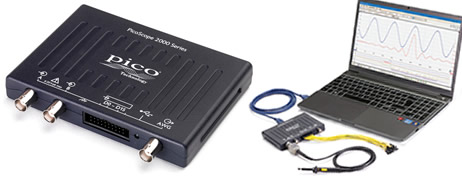
|
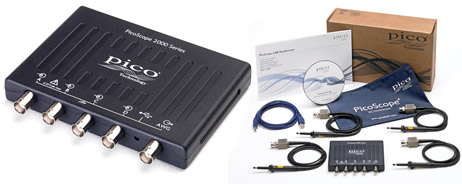
|
Your Complete Test & Measurement Laboratory
You can use your PicoScope 2000 Series as an advanced oscilloscope, spectrum Analyser, function generator, arbitrary waveform generator and protocol decoder out of the box. Mixed signal models also add a 16 channel logic Analyser. A complete electronics lab in one compact, low-cost, USB-powered unit.
The PicoScope 2000A models deliver unbeatable value for money and are ideal for education, hobby and field service use. In the lab the low cost allows one scope per person rather than having to share.
The PicoScope 2000B models have the added benefits of deep memory (up to 128 MS), higher bandwidth (up to 100 MHz) and faster waveform update rates. PicoScope 2000B models give you the performance to carry out advanced analysis of your waveforms. They are ideal for design, debug and serial decoding.
High-End Oscilloscope
At the heart of every PicoScope 2000 is an advanced oscilloscope which offers everything you would expect and much more besides:
- 10,000 waveform circular buffer
- Up to 80,000 waveforms per second update rate
- Mask limit testing
- Advanced math & filtering
- Measurements with statistics
- Advanced digital triggering
- Resolution enhancement to 12 bits
Logic Analyser / Mixed Signal Ability
The PicoScope 2000 Series includes mixed signal models that include 16 digital inputs so that you can view digital and analog signals simultaneously.
The digital inputs can be displayed individually or in named groups with binary, decimal or hexadecimal values shown in a bus-style display. A separate logic threshold from -5 V to +5 V can be defined for each 8-bit input port. The digital trigger can be activated by any bit pattern combined with an optional transition on any input. Advanced logic triggers can be set on either the analog or digital input channels, or both to enable complex mixed-signal triggering.
The digital inputs bring extra power to the serial decoding options. You can decode serial data on all analog and digital channels simultaneously, giving you up to 18 channels of data. You can for example decode multiple SPI, I²C, CAN bus, LIN bus and FlexRay signals all at the same time!
- Oscilloscope controls: PicoScope's full analog-domain controls, including zoom, filtering, and signal generator, are all available in MSO digital signal mode.
-
Digital channels button:
Set up and display digital inputs. View analog and digital signals on the same timebase. -
Serial decode:
Decoded data can be displayed above the waveform or in a spreadsheet style table. - Split-screen display: PicoScope can display both analog and digital signals at the same time. The split-screen display can be adjusted to give more or less space to the analog waveforms.
-
Display format:
Display selected bits individually or as groups in numerical or ASCII format. -
Analog waveforms:
View analog waveforms time-correlated with digital inputs. The large, high resolution display area ensures multiple analog and digital inputs can clearly be seen.
Serial Bus Decoding and Protocol Analysis
PicoScope can decode 1-Wire, ARINC 429, CAN, DCC, DMX512, Ethernet, FlexRay, I²C, I²S, LIN, PS/2, SENT, SPI, UART (RS-232 / RS-422 / RS-485), and USB protocol data as standard, with more protocols in development and available in the future with free-of-charge software upgrades.
Multiple protocols can be captured and decoded, the only limit being the number of available channels (18 for MSO models). The ability to observe data flow across a bridge (such as CAN bus in, LIN bus out) is incredibly powerful.
The deep memory buffers make the PicoScope 2000B models ideal for serial decoding as it is possible to capture and decode many thousands of frames of data.
FFT Spectrum Analyser
The spectrum view plots amplitude against frequency, revealing details that would otherwise be hidden in an oscilloscope view. It is ideal for finding noise, crosstalk or distortion in signals.
You can display multiple spectrum views alongside oscilloscope views of the same data. A comprehensive set of automatic frequency-domain measurements can be added to the display, including THD, THD+N, SNR, SINAD and IMD. A mask limit test can be applied to a spectrum and you can even use the AWG and spectrum mode together to perform swept scalar network analysis.
With PicoScope 2000B models FFTs of up to 1 million points can be computed in milliseconds giving superb frequency resolution. Increasing the number of points in a FFT also lowers the noise floor revealing otherwise hidden signals.
Arbitrary Waveform Generator (AWG) and Function Generator
All PicoScope 2000 Series oscilloscopes have a built-in function generator and arbitrary waveform generator (AWG) which output signals on a front panel BNC.
The function generator can produce sine, square, triangle and DC level waveforms, and many more besides, while the AWG allows you to import custom waveforms from data files or create and modify them using the built-in graphical AWG editor.
As well as level, offset and frequency controls, advanced options allow you to sweep over a range of frequencies. Combined with the advanced spectrum mode, with options including peak hold, averaging and linear/log axes, this creates a powerful tool for testing amplifier and filter responses.
PicoScope 2000B models have trigger options that allow one or more cycles of a waveform to be output when various conditions are met, such as the scope triggering or a mask limit test failing.
Download New Features or Write Your Own
The software development kit (SDK) allows you to write your own software and includes drivers for Microsoft Windows, Apple Mac (OS X) and Linux (including Raspberry Pi and BeagleBone).
Example code shows how to interface to third-party software packages such as Microsoft Excel, National Instruments LabVIEW and MathWorks MATLAB.
There is also an active community of PicoScope users who share code and applications on both the forum and PicoApps section of the web site. The Frequency Response Analyser shown opposite is one of the most popular 3rd party applications.
| Model | Picoscope | ||||||
|---|---|---|---|---|---|---|---|
Bandwidth |
10 MHz |
25 MHz |
50 MHz |
70 MHz |
100 MHz |
||
2 Channel |
2204A |
2205A |
2206B |
2207B |
2208B |
||
4 Channel |
2405A |
2406B |
2407B |
2408B |
|||
2 Channel MSO |
2205A MSO |
2206B MSO |
2207B MSO |
2208B MSO |
|||
| Oscilloscope — vertical (analog inputs) | |||||||
Bandwidth |
10 MHz | 25 MHz | 50 MHz | 70 MHz | 100 MHz | ||
| Rise time (calculated) | 35 ns | 14 ns | 7 ns | 5 ns | 3.5 ns | ||
| Vertical resolution | 8 bits | ||||||
| Enhanced vertical resolution | Up to 12 bits | ||||||
| Input ranges | ±50 mV, ±100 mV, ±200 mV, ±500 mV, ±1 V, ±2 V, ±5 V, ±10 V, ±20 V | ±20 mV, ±50 mV, ±100 mV, ±200 mV, ±500 mV, ±1 V, ±2 V, ±5 V, ±10 V, ±20 V | |||||
| Input sensitivity (10 vertical divisions) | 10 mV/div to 4 V/div | 4 mV/div to 4 V/div | |||||
| Input coupling | AC / DC | ||||||
| Input connector | BNC(f) | ||||||
| Input characteristics | 1 MΩ ± 1% || 14 pF ± 2 pF | 1 MΩ ± 1% || 16 pF ± 1 pF | |||||
| Analog offset range (vertical position adjustment) | None | ±250 mV (20 mV to 200 mV ranges) ±2.5 V (500 mV to 2 V ranges) ±25 V (5 V to 20 V ranges) |
|||||
| Analog offset control accuracy | N/A | ±1% of offset setting, additional to basic DC accuracy | |||||
| DC accuracy | ±3% of full scale ±200 µV | ||||||
| Overvoltage protection | ±100 V (DC + AC peak) | ||||||
| Oscilloscope — vertical (digital inputs, MSOs only) | |||||||
Input channels |
16 channels (2 ports of 8 channels each) | ||||||
| Input connectors | 2.54 mm pitch, 10 x 2 way connector | ||||||
| Maximum input frequency | 100 MHz (200 Mb/s) | ||||||
| Minimum detectable pulse width | 5 ns | ||||||
| Input impedance | 200 kΩ ±2% || 8 pF ±2 pF | ||||||
| Input dynamic range | ±20 V | ||||||
| Digital threshold range | ±5 V | ||||||
| Overvoltage protection | ±50 V | ||||||
| Threshold grouping | Two independent threshold controls: Port 0: D0 to D7, Port 1: D8 to D15 | ||||||
| Threshold selection | TTL, CMOS, ECL, PECL, user-defined | ||||||
| Port threshold accuracy | ±350 mV (inclusive of hysteresis) | ||||||
| Hysteresis | < ±250 mV | ||||||
| Minimum input voltage swing | 500 mV pk-pk | ||||||
| Channel-to-channel skew | 2 ns typical | ||||||
| Minimum input slew rate | 10 V/µs | ||||||
| Oscilloscope — Horizontal | |||||||
Maximum Sampling Rate (real-time) |
100 MS/s |
200 MS/s |
500 MS/s |
500 MS/s |
1 GS/s |
1 GS/s |
1 GS/s |
| Equivalent sampling rate (ETS mode) |
2 GS/s | 4 GS/s | 5 GS/s | 10 GS/s | |||
| Maximum sampling rate (USB streaming) |
1 MS/s | 9.6 MS/s | |||||
| Shortest timebase | 10 ns/div | 5 ns/div | 2 ns/div | 1 ns/div | |||
| Longest timebase | 5000 s/div (approx 14 hours per waveform in chart recorder view) | ||||||
| Buffer memory (block mode)* | 8 kS | 16 kS | 48 kS | 32 MS | 32 MS | 64 MS | 128 MS |
| Buffer memory (USB streaming mode) | 100 MS (shared between active channels) | ||||||
| Waveform buffers | 10 000 | ||||||
| Maximum waveforms per second | 2000 | 80 000 | |||||
| Initial timebase accuracy | ±100 ppm | ±50 ppm | |||||
| Timebase drift | ±5 ppm / year | ||||||
| Sample jitter | 30 ps RMS typical | 20 ps RMS typical | 3 ps RMS typical | ||||
| ADC sampling | Simultaneous | ||||||
| * Maximum sampling rate and buffer memory are shared between active channels. On MSO models each group of 8 inputs counts as a channel. Maximum sampling rate on MSO digital channels is 500 MS/s. | |||||||
| Dynamic Performance | |||||||
| Crosstalk (full bandwidth) | Better than 200:1 | Better than 300:1 | |||||
| Harmonic distortion | < -50 dB at 100 kHz, full scale input, typical | ||||||
| SFDR (100 kHz, full-scale input, typical) |
> 52 dB | ±20 mV range: > 44 dB ±50 mV range and higher: > 52 dB |
|||||
| Noise | < 150 μV RMS (±50 mV range) | < 220 μV RMS (±20 mV range) | < 300 μV RMS (±20 mV range) | ||||
| Bandwidth Flatness (at scope input) | (+0.3 dB, -3 dB) from DC to full bandwidth | ||||||
| Triggering | |||||||
| Sources | Ch A, Ch B, Ch C, Ch D. Any MSO digital channel | ||||||
| Trigger Modes | None, auto, repeat, single | None, auto, repeat, single, rapid (segmented memory) | |||||
| Advanced Triggers | Edge, window, pulse width, window pulse width, dropout, window dropout, interval, logic. | Edge, window, pulse width, window pulse width, dropout, window dropout, interval, runt pulse, logic | |||||
| Trigger types, ETS | Rising or falling edge | Rising or falling edge (available on Ch A only) | |||||
| Trigger sensitivity, real-time | Digital triggering provides 1 LSB accuracy up to full bandwidth | ||||||
| Trigger sensitivity, ETS | 10 mV p-p, typical, at full bandwidth | ||||||
| Maximum pre–trigger capture | 100% of capture size | ||||||
| Maximum post–trigger delay | 4 billion samples | ||||||
| Trigger re–arm time in rapid trigger mode |
N/A | < 2 µs on fastest timebase | < 1 µs on fastest timebase | ||||
| Max. waveforms in rapid trigger mode | N/A | 96 | 10 000 | ||||
| Function Generator | |||||||
| Standard output signals | Sine, square, triangle, DC voltage, ramp, sinc, Gaussian, half sine | ||||||
| Pseudorandom output signals | None | White noise, PRBS | |||||
| Standard signal frequency | DC to 100 kHz | DC to 1 MHz | |||||
| Sweep modes | Up, down, dual with selectable start/stop frequencies and increments | ||||||
| Output frequency accuracy | ±100 ppm | ±50 ppm | |||||
| Output frequency resolution | < 0.01 Hz | ||||||
| Output voltage range | ±2 V | ||||||
| Output adjustments | Any amplitude and offset within ±2 V range | ||||||
| Amplitude flatness (typical) | < 1 dB to 100 kHz | < 0.5 dB to 1 MHz | |||||
| DC accuracy | ±1% of full scale | ||||||
| SFDR | > 55 dB @ 1 kHz full scale sine wave | > 60 dB @ 10 kHz full scale sine wave | |||||
| Connector type | Front panel BNC with 600 Ω output impedance | ||||||
| Overvoltage protection | ±10 V | ||||||
| Arbitrary Waveform Generator | |||||||
| Update rate | 2 MS/s | 20 MS/s | |||||
| Buffer size | 4 kS | 8 kS | |||||
| Resolution | 12 bits | ||||||
| Bandwidth | 100 kHz | >1 MHz | |||||
| Rise time (10% to 90%) | < 2 µs | < 120 ns | |||||
| Spectrum Analyser | |||||||
| Frequency Range | DC to analog bandwidth of oscilloscope | ||||||
| Display modes | Magnitude, peak hold, average | ||||||
| Windowing functions | Rectangular, Gaussian, triangular, Blackman, Blackman Harris, Hamming, Hann, flat top | ||||||
| Number of FFT points | Selectable from 128 to half the available buffer memory in powers of 2, up to a maximum of 1 048 576 points | ||||||
| Math channels and Software filters | |||||||
| Functions | −x, x+y, x−y, x*y, x/y, x^y, sqrt, exp, ln, log, abs, norm, sign, sin, cos, tan, arcsin, arccos, arctan, sinh, cosh, tanh, freq, derivative, integral, min, max, average, peak, delay, duty | ||||||
| Software filters | Highpass, lowpass, bandpass, bandstop | ||||||
| Operands | A, B (input channels), C, D (input channels, 4-channel models only), T (time), reference waveforms, constants, pi, digital channels (MSO models only) | ||||||
| Automatic Measurements | |||||||
| Scope Mode | AC RMS, true RMS, frequency, cycle time, duty cycle, DC average, falling rate, rising rate, low pulse width, high pulse width, fall time, rise time, minimum, maximum, peak to peak | ||||||
| Spectrum Mode | Frequency at peak, amplitude at peak, THD dB, SNR, SINAD, SFDR, total power, average amplitude at peak, THD %, THD+N, IMD | ||||||
| Statistics | Minimum, maximum, average and standard deviation | ||||||
| Serial Decoding | |||||||
| Protocols | 1-Wire, ARINC 429, CAN, DCC, DMX512, FlexRay, Ethernet 10Base-T, USB 1.1, I²C, I²S, LIN, PS/2, SPI, SENT, UART/RS-232 (subject to bandwidth and sampling rate of chosen oscilloscope model) | ||||||
| Mask Limit Testing | |||||||
| Mask generation | Numeric (automatic) or Graphical (manual) | ||||||
| Statistics | Pass/fail, failure count, total count | ||||||
| Available actions on mask fail | Beep, play sound, stop capture, save waveform, trigger signal generator / AWG, run executable | ||||||
| Display | |||||||
| Interpolation | Linear or sin(x)/x | ||||||
| Persistence Modes | Digital color, analog intensity, custom, or none | ||||||
| SDK / API details and specifications for customers writing their own software | |||||||
| Supplied drivers | 32 and 64-bit drivers for Windows 7, 8 and 10, Linux drivers, Mac OS X drivers | ||||||
| Example code | C, C#, Excel VBA, VB.NET, LabVIEW, MATLAB | ||||||
| Maximum USB streaming sampling rate* |
1 MS/s | 5 MS/s | 31 MS/s | ||||
| Buffer memory in USB streaming mode* | Limited only by PC | ||||||
| Segmented memory buffers* | N/A | 96 | 128000 | 256000 | 512000 | ||
| * These specifications apply when using the drivers / writing your own software. Refer to Horizontal section above when using PicoScope software | |||||||
| General | |||||||
| Package contents |
PicoScope 2000 series oscilloscope 2 or 4 switchable 10:1/1:1 oscilloscope probes (except for PicoScope 2204A / 2205A when purchased without probes) TA136 digital cable (MSOs only) 2 x TA139 pack of 10 logic test clips (MSOs only) USB cable, Software and reference CD, Quick start guide |
||||||
| PC Connectivity | USB 2.0 (USB 1.1 and 3.0 compatible). USB cable included. | ||||||
| Power Requirements | Powered from USB port | ||||||
| Dimensions (including connectors) | 142 x 92 x 19 mm, < 0.2 kg | 130 x 104 x 18.8 mm, < 0.2 kg | |||||
| Temperature range, operating | 0 °C to 50 °C | ||||||
| Temperature range, operating for stated accuracy | 15 °C to 30 °C | ||||||
| Temperature range, storage | -20 °C to +60 °C | ||||||
| Humidity range, operating | 5% to 80% RH non-condensing | ||||||
| Humidity range, storage | 5% to 95% RH non-condensing | ||||||
| Altitude range | up to 2000 m | ||||||
| Pollution degree | 2 | ||||||
| Safety approvals | Designed to EN 61010-1:2010 | ||||||
| Pollution degree | 2 | ||||||
| Environmental approvals | RoHS, WEEE | ||||||
| EMC approvals | Tested to meet EN61326-1:2013 and FCC Part 15 Subpart B | ||||||
| Software included |
PicoScope 6 for Microsoft Windows 7, 8 and 10 32-bit and 64-bit SDK for Windows 7, 8 and 10 32-bit and 64-bit example programs (C, Microsoft Excel VBA, LabVIEW) |
||||||
| Free software available for download |
PicoScope 6 (beta) for Linux and OS X. Please note that the Linux and OS X beta versions of PicoScope do not yet have mask limit test or math channel functions. SDK (beta) for Linux and OS X | ||||||
| Languages supported | Simplified Chinese, Czech, Danish, Dutch, English, Finnish, French, German, Greek, Hungarian, Italian, Japanese, Korean, Norwegian, Polish, Portuguese, Romanian, Russian, Spanish, Swedish, Turkish | ||||||

